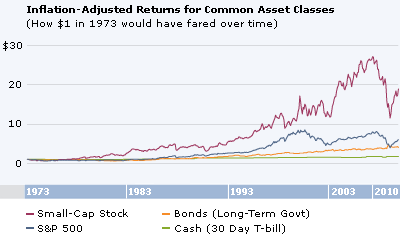| What's the Payoff? Historical Returns of the Asset Classes |
| The most accurate answer is that nobody knows how the asset classes are going to perform. The greatest stock-picking method in the world cannot predict the future. Nobody knows what the stock market is going to do tomorrow, let alone in a year or 10 years from now. That's why there's a disclaimer that every mutual fund company in the country has to use in its sales literature: "Past performance is no guarantee of future results." |
| You can, however, make some general assumptions based on historical performance of the three main asset classes: (stock), fixed income (bonds), and cash (such as money-market accounts). |
| Stocks have generally outperformed both bonds and cash, offering investors average annualized total returns of 9.81% since 1926 (based on S&P 500). During that same period, the average total return for long-term government bonds was 5.42% and cash was 3.66%. Although stocks offered the greatest return potential, they experienced the highest level of volatility during that period (the best year for stocks was 1933 with total returns of 53.99% and its worst year was 1931 with total returns of 43.31%). |
| One thing to keep in mind is that within these three classes there has been great variety in returns. Small-cap stocks, for instance, have historically offered the highest equity returns. Similarly, corporate bonds have offered higher returns than government bonds. Treasury Bills have been pretty much the lowest earners, with an average rate of return of less than 4% monthly annualized compound average return. |
| When deciding how to allocate your contributions among the asset classes, you also should look at the rate of inflation. Inflation is what makes something that used to cost $10 in 1970 cost $55 today, meaning that your money doesn't buy as much as it used to. If you want to have enough money to live well in retirement, your investment return has to compensate for the inevitably higher prices that will exist decades from now. That means assuming some risk by investing in higher-return investments. |

|
| For instance, if you invested $1,000 in a cash account (such as a CD) yielding 5%, you could grow your investment to $1,629 over 10 years. But assuming a 3% inflation rate (over the past 70 years, inflation has averaged more than 4% per year), this sum would actually be worth only $1,201 of today's dollars. At 4% inflation, you would have only $1,083–not a lot to show for 10 years' worth of investing. |
| The moral of this story? Every day your money is worth a little less than it was the day before. Whether you call yourself a saver or an investor, you've got to keep moving just to stay in place. And if you want to get ahead, you really have to run. |
|
> Home
> Glossary > Support |